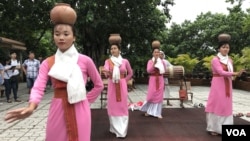The ethnic minorities in Vietnam most likely to escape poverty are those who have good infrastructure, sell cash crops besides rice, and look for factory work, according to a report from the World Bank released on Wednesday.
The government plans by the year 2020 to incorporate findings from the report into a strategy for socio-economic development in underserved areas.
"We find this research a valuable source of reference for our policy formulation process, especially at the time when we are now working with concerned ministries and provinces to draw up a master proposal on comprehensive investment" for minorities, said Do Van Chien, who is minister chairman of the government's Committee for Ethnic Minority Affairs (CEMA).
The report indicates that minorities will have a better chance to catch up if Vietnam focuses on connectivity in all its forms. That means more infrastructure, from bridges for transporting their products, to internet access for staying informed. It also means the ability to connect to business networks, whether for job openings, supply chain relationships, or other partnerships.
The communist country has 54 ethnic groups that are recognized officially by the government, though others exist as well. These range from the Cham civilization that built ancient towers in the south before the Kinh came from the north, to the K'Ho people of the central highlands, to the Montagnards, who were marginalized after aiding the United States in the Vietnam War.
The difficulties faced by Vietnam's ethnic minorities extends beyond the past few years.
The World Bank estimates that the poverty level among minorities in Vietnam was 23 percent in 2016, about three times the national rate. It said that minorities could account for 84% of the country's population who are still poor by 2020.
Ousmane Dione, the World Bank's country director in Vietnam, hopes some of that can change with suggestions from his office's latest report, Drivers of Socio-Economic Development Among Ethnic Minority Groups in Vietnam.
"From the study, we see tremendous opportunities to further advance the inclusion agenda by consciously adopting a differentiated approach toward development in ethnic minority areas," Dione said. "Vietnam can count on the World Bank's support in mainstreaming this agenda through investments in transport and infrastructure in rural and mountainous areas, [and] agricultural diversification."






